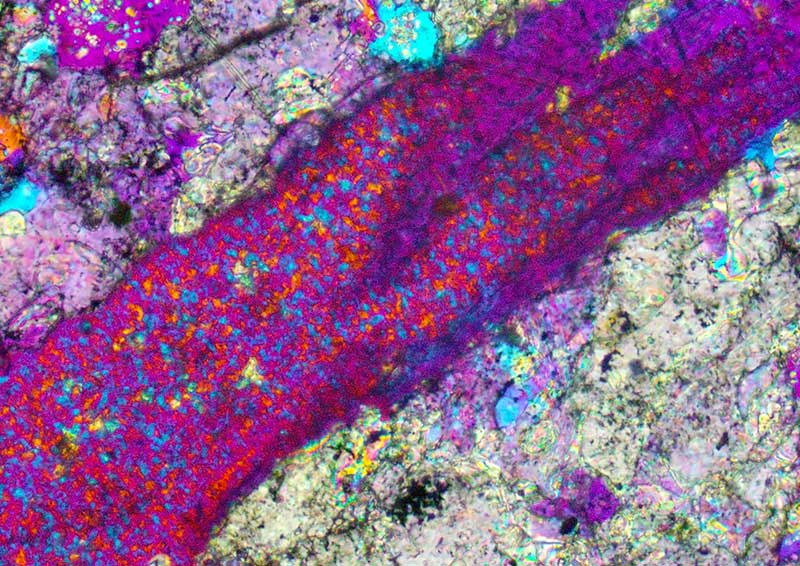Alkali-aggregate reaction (AAR)
(Microscopic view of crystalline AAR product in cracked aggregate from a concrete bridge (Leemann et al, 2016).)
[edit] Introduction
The dominance of Portland cement concrete as the world's pre-eminent structural material developed during the 19th century and continued throughout the 20th century and retains that position today.
However, the material had a 'guilty secret' that was only revealed by research in the USA during the 1930s. In some circumstances, an expansive reaction can gradually occur between aggregate constituents and alkaline hydroxides from the cement, causing damage to the hardened concrete within structures.
This has become known as 'alkali-aggregate reaction' (AAR), or most commonly and more specifically, 'alkali-silica reaction' (ASR). This AAR family of mechanisms is by no means the most frequently encountered threat to concrete durability or the serviceability of structures, but it can be a serious issue when it occurs.
It has continued to fascinate concrete research scientists and engineers ever since its first published description, some 76 years ago.
[edit] Getting to grips with AAR
Over more than 40 years, I have been privileged to witness practising engineers and applied scientists getting to grips with AAR worldwide. I believe we now understand the several reactions, including how to recognise them in existing structures and manage the situation, but crucially also including how to determine any possible AAR potential in new works and take effective precautionary measures.
However, challenges remain, especially as appreciation of the potential threat from AAR is not universally or equally appreciated everywhere in the world, and we are still finding types of structure that behave exceptionally. Overall, the prospects are encouraging for both a declining incidence of AAR damage and successful approaches to management and/or repair of affected cases.
This article was originally published by ICE on 30 June 2016. It was written by Simon Fullalove. You can see the original article here.
--The Institution of Civil Engineers
[edit] Related articles on Designing Buildings Wiki
Featured articles and news
Ebenezer Howard: inventor of the garden city. Book review.
The Grenfell Tower fire, eight years on
A time to pause and reflect as Dubai tower block fire reported just before anniversary.
Airtightness Topic Guide BSRIA TG 27/2025
Explaining the basics of airtightness, what it is, why it's important, when it's required and how it's carried out.
Construction contract awards hit lowest point of 2025
Plummeting for second consecutive month, intensifying concerns for housing and infrastructure goals.
Understanding Mental Health in the Built Environment 2025
Examining the state of mental health in construction, shedding light on levels of stress, anxiety and depression.
The benefits of engaging with insulation manufacturers
When considering ground floor constructions.
Lighting Industry endorses Blueprint for Electrification
The Lighting Industry Association fully supports the ECA Blueprint as a timely, urgent call to action.
BSRIA Sentinel Clerk of Works Training Case Study
Strengthening expertise to enhance service delivery with integrated cutting-edge industry knowledge.
Impact report from the Supply Chain Sustainability School
Free sustainability skills, training and support delivered to thousands of UK companies to help cut carbon.
The Building Safety Forum at the Installershow 2025
With speakers confirmed for 24 June as part of Building Safety Week.
The UK’s largest air pollution campaign.
Future Homes Standard, now includes solar, but what else?
Will the new standard, due to in the Autumn, go far enough in terms of performance ?
BSRIA Briefing: Cleaner Air, Better tomorrow
A look back at issues relating to inside and outside air quality, discussed during the BSRIA briefing in 2023.
Restoring Abbotsford's hothouse
Bringing the writer Walter Scott's garden to life.
Reflections on the spending review with CIAT.
Retired firefighter cycles world to raise Grenfell funds
Leaving on 14 June 2025 Stephen will raise money for youth and schools through the Grenfell Foundation.
Key points for construction at a glance with industry reactions.
























